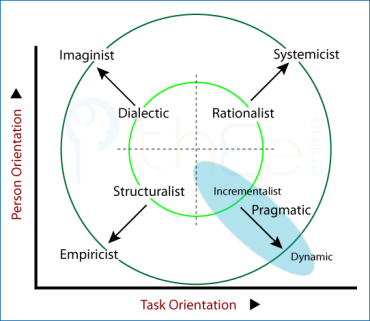Antagonisms & Affinities
In any TET, types in diagonally opposite quadrants show an antagonism to each other, while those types in the same quadrant have an affinity.
Antagonisms

● The is oriented to design: from the smallest project completed in days to the creation of the grandest plan taking 10 years or more.
● By contrast, the is oriented to control of what exists—showing up in a desire for precision and bureaucratic punctiliousness.
● The is about taking action, whether on small matters or as part of major changes.
● By contrast, the is about support for individuals whether on their own or as members of a group or a department.
The conflicting assumptions in the quadrants also show up preferences for:
► type of environment , &
► type of issue.
● The supporters can handle stable situations with complex issues,
while the doers prefer changing situations but straightforward issues.
● The designers prefer change and complexity,
while the controllers like stability and straightforward issues.
Affinities

In any quadrant, those who adhere to a type that is central tend to view the type that is peripheral as more sophisticated and worthy of activating or emulating. So there is a centrifugal force in operation as shown.
● In the quadrant, both approaches are working with personal values and interests, but the goes deeper than the can.
● In the quadrant, both approaches work with the design of work and outputs, but the does this more comprehensively and cleverly than the .
● In the quadrant, both approaches emphasize documentation and seek tight control of what is going on, but the can be more precise and detailed than the .
● In the quadrant, all approaches deal with action, but the form is viewed as far more capable and effective than the .
We have now got a fix on the 7 approaches and their relationships to each other. That makes it possible to look at:
- The value of combining approaches,
- And combinations that have implications for leadership style.
Originally posted: 21-Apr-2011